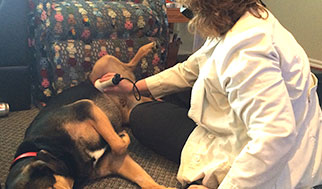Laser Therapy
 When I started practicing veterinary medicine over 20 years ago, one of my biggest frustrations was when we just could not help anymore. Some conditions just progressed, and impacted a pet’s life for the worse, no matter what medications we used. The worst cases were the large breed older dogs, whose arthritis got so bad they just could not get up or walk anymore.
When I started practicing veterinary medicine over 20 years ago, one of my biggest frustrations was when we just could not help anymore. Some conditions just progressed, and impacted a pet’s life for the worse, no matter what medications we used. The worst cases were the large breed older dogs, whose arthritis got so bad they just could not get up or walk anymore.
That was a big part of my motivation for getting into Laser Therapy. It gives us new options to treat:
- Longstanding inflammation
- Arthritis
- Chronic Skin Conditions
- Acute trauma
- Burns
- Lacerations
How does it work?
- It works at a cellular level – it actually affects the production of energy in the fuel factories (mitochondria) of the cells. This not only lets cells do their jobs better and faster, it causes the cells to send out signal chemicals that decrease pain, decrease inflammation, and promote healing.
- It penetrates deeply – a Class IV Laser is strong enough to penetrate to a depth of 8 cm. This means it can even be beneficial for inflammation inside the abdomen, like a painful infected bladder.
What are the effects?
I’ll divide them into time-frame, Immediate, Fast, and Gradual:
Immediate – It produces Pain Relief! It does this in 2 ways:
- “Resets” the nerves that conduct pain signals – when pain has been going on for a while, the resting level of the nerve is such that even a normal touch can trigger the sending of a pain signal. The laser set the resting potential of these nerves back down so that it takes an actual pain stimulus to trigger the sending of a pain signal.
- Causing the cells to secrete chemical signals that decrease pain – these include endorphins, the body’s natural pain blocker; and acetylcholine, which helps normalize nerve signalling.
Fast – It decreases swelling and inflammation:
- Some of the chemical signals the cells release (serotonin and nitrous oxide) cause vessels to open up – both blood vessels, to deliver more nutrients and “clean-up” cells, and lymphatic vessels. Opening the lymphatic vessels allows the excess fluid of swelling to drain away.
- It causes a change in the chemical mediators the cells release: for ones that promote inflammation (bradykinins, interleukins) to ones that do not promote or even inhibit inflammation (prostacyclins).
Gradual – It facilitates healing:
- The opening of blood vessels, mentioned above, means more oxygen, nutrients and cells getting delivered to the area.
- The boost in the metabolism of the cells means that they do their jobs faster – whether that is dividing into more cells to cover a wound, or producing proteins to knit tissues back together, or gobbling up debris, or making antibodies as part of the immune response.
- The chemical signals that the cells give off serve to “call in” more cells from other parts of the body to help with repair and healing.

